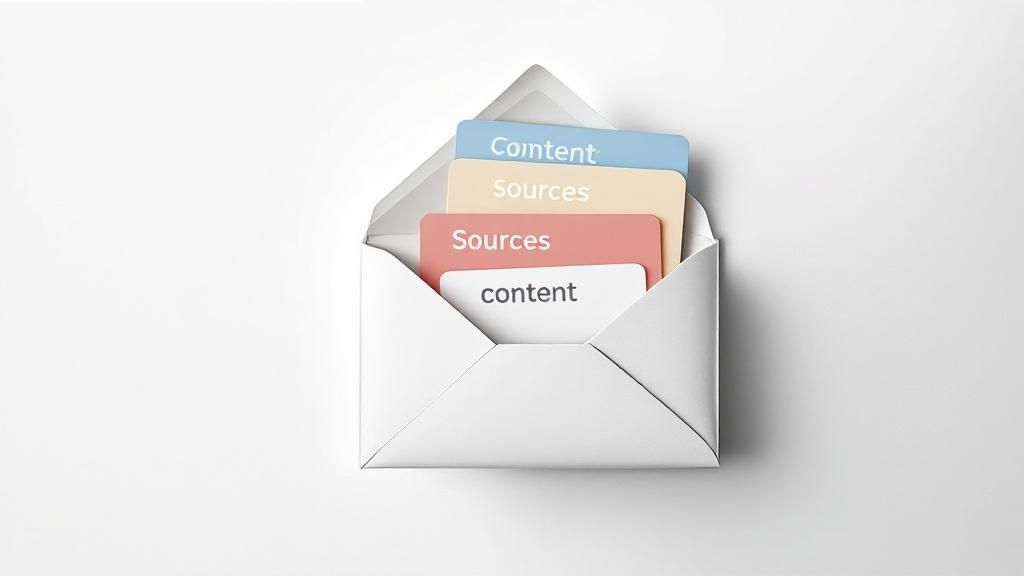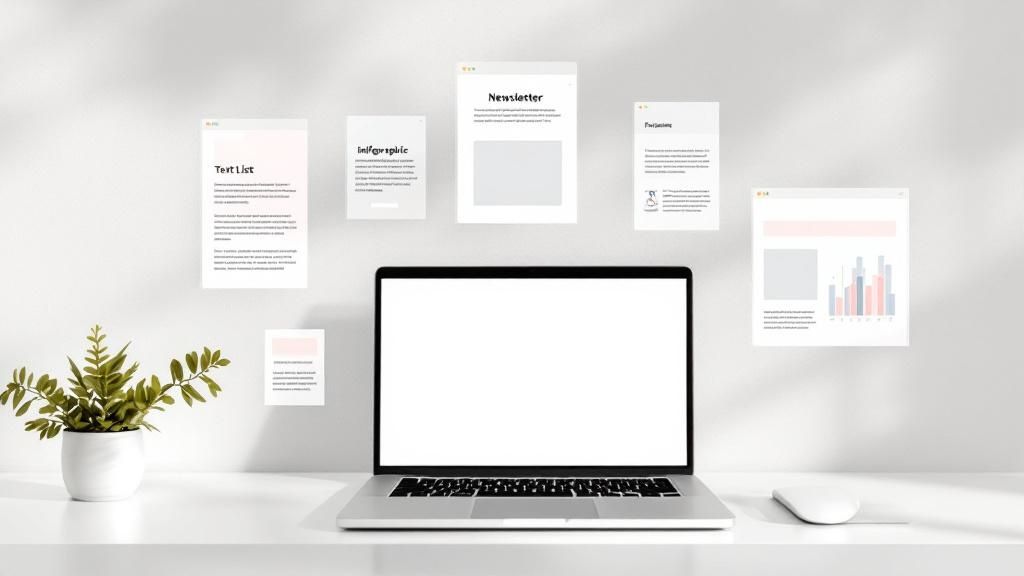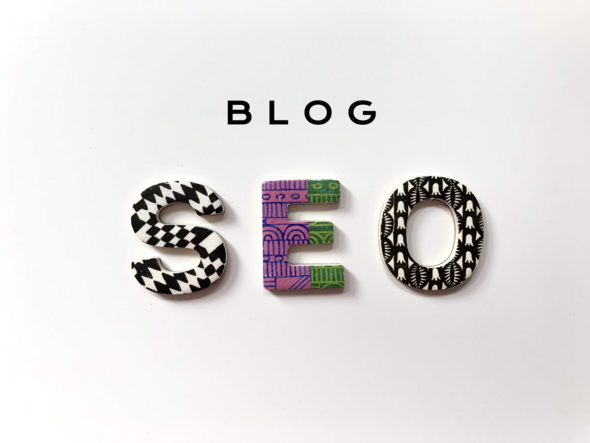Newsletters that Really Connect: Find Your Perfect Fit
Want to engage your audience and achieve your content marketing goals? A newsletter is key. Choosing the right type of newsletter is even more critical. This guide explores seven different types of newsletters, from curated content and educational pieces to product updates and interview-based formats. Whether you're a small business owner, marketer, or blogger, discover the perfect newsletter format to connect with your subscribers and make your content a must-read in 2025. This list will help you select the best type of newsletter for your specific audience and goals.
1. Curated Newsletter
One of the most effective types of newsletter for establishing thought leadership and providing value to your audience is the curated newsletter. This format aggregates and organizes the best content from various sources around a specific topic or industry. Think of it as a digital digest, hand-picked and delivered straight to your subscribers' inboxes. The curator acts as a filter, sifting through the noise and selecting, summarizing, and contextualizing relevant articles, resources, and insights. This saves readers significant time while providing valuable, targeted information. Rather than spending hours trawling the web, your audience receives a pre-vetted collection of the most important updates and perspectives. This not only keeps them informed but also positions you as a knowledgeable and reliable source within your niche.

A well-executed curated newsletter typically features hand-picked content from multiple sources, offering a diverse range of perspectives. It often includes editorial commentary and analysis, adding the curator's unique insights and interpretation to the selected pieces. Categorized sections allow for easy navigation, enabling readers to quickly find topics of interest. Brief summaries of longer articles offer a quick overview, allowing subscribers to decide which pieces warrant a deeper dive. Finally, a good curated newsletter provides a balanced mix of news, insights, and resources, catering to various informational needs. This blend ensures the newsletter remains engaging and relevant, consistently delivering value to the reader.
Successful examples of curated newsletters abound. Morning Brew, focused on business and financial news, has gained a massive following for its concise and engaging format. The Hustle delivers a daily dose of tech and business stories, while Benedict Evans provides in-depth analysis of the tech industry. CB Insights offers curated intelligence on startups and venture capital. These newsletters demonstrate the power of curation to attract and retain a loyal audience. They also highlight the potential for building a strong brand and establishing oneself as a go-to source of information within a specific field.
The benefits of a curated newsletter are numerous. It positions the sender as an industry expert, showcasing their ability to identify and analyze key trends and developments. It saves readers significant time, offering a convenient and efficient way to stay informed. This, in turn, builds authority and trust, fostering a strong relationship between the curator and their audience. From a practical standpoint, curated newsletters can be relatively quick to produce once a workflow is established. The high perceived value for subscribers contributes to increased engagement and loyalty. You can Learn more about Curated Newsletter and how to implement effective content marketing strategies around it.
However, curating a newsletter also presents challenges. It requires extensive daily reading and research to identify relevant and high-quality content. There’s a risk of copyright issues if content isn't properly attributed. The quality of the newsletter is dependent on the quality of the external content being curated, and maintaining consistent quality and a regular publishing schedule can be demanding.
For those looking to leverage this powerful type of newsletter, here are some actionable tips: establish consistent content categories to provide structure and predictability; always provide proper attribution and links to original sources; add your unique perspective to each curated item to differentiate your newsletter and offer added value; use tools like Feedly or Pocket for efficient content discovery; and maintain a consistent publishing schedule to build anticipation and habit among your subscribers. This type of newsletter is particularly well-suited for small business owners, digital marketing professionals, independent bloggers and writers, web agencies, freelancers, and non-technical entrepreneurs looking to establish thought leadership, build a community, and provide valuable insights to their target audience. By thoughtfully curating and contextualizing relevant content, you can establish yourself as a trusted source of information and cultivate a loyal following.
2. Educational Newsletter
Among the various types of newsletter, the educational newsletter stands out as a powerful tool for building a loyal audience, establishing authority, and even generating revenue. This format focuses on delivering value through structured learning, making it an ideal choice for businesses and individuals looking to share their expertise and foster a dedicated community. Instead of simply broadcasting information, an educational newsletter adopts a curriculum-like approach, progressively building subscribers' knowledge and skills within a specific niche.
This approach works by delivering consistent, high-quality educational content directly to subscribers' inboxes. Instead of requiring them to actively seek out information, you bring the learning experience to them. This convenience, combined with the structured format, fosters high engagement and encourages consistent consumption of your content.
Features of an Effective Educational Newsletter:
- Step-by-step tutorials and lessons: Breaking down complex topics into digestible modules makes learning easier and more accessible for subscribers.
- Progressive skill building: Each issue builds upon previous lessons, creating a clear learning pathway and fostering a sense of accomplishment.
- Actionable learning objectives: Clearly defined objectives help subscribers understand what they will gain from each issue and stay motivated.
- Practical exercises and assignments: Reinforce learning and encourage active participation by providing opportunities to apply newly acquired knowledge.
- Resource recommendations and further reading: Expand subscribers' understanding and encourage further exploration beyond the newsletter's scope.
Pros of Using an Educational Newsletter:
- High engagement and subscriber retention: The value-driven approach fosters a loyal audience eager for each new installment.
- Positions sender as a subject matter expert: Consistently delivering valuable educational content establishes credibility and authority within your niche.
- Creates strong reader dependency: As subscribers progress through your curriculum, they become reliant on your newsletter for continued learning, strengthening their connection to your brand.
- Excellent for course or product upselling: An educational newsletter can serve as a powerful lead magnet, nurturing subscribers and preparing them for higher-value offerings.
- Measurable learning outcomes: You can track subscriber progress and engagement to assess the effectiveness of your educational content.
Cons of Using an Educational Newsletter:
- Requires deep subject matter expertise: You need a strong understanding of the topic you're teaching to create credible and accurate content.
- Time-intensive content creation: Developing structured lessons and practical exercises requires significant time and effort.
- Need for consistent quality and accuracy: Maintaining a high standard of quality is crucial for building trust and credibility.
- Pressure to continuously provide new insights: Subscribers expect fresh perspectives and valuable information in each issue, demanding ongoing research and content development.
Examples of Successful Educational Newsletters:
- JavaScript Weekly: Focuses on programming education, providing tutorials, tips, and resources for JavaScript developers.
- Marketing Examples: Shares real-world marketing case studies and lessons, offering practical insights for marketers.
- The Diff: Delivers in-depth analysis of finance and economics, educating subscribers on complex financial concepts.
- Dense Discovery: Explores design and technology trends, providing insightful commentary and learning resources. These examples showcase the versatility of the educational newsletter format across diverse industries.
Tips for Creating a Successful Educational Newsletter:
- Start with a clear learning pathway: Outline the skills or knowledge areas you'll cover and how each issue contributes to the overall learning journey.
- Include practical exercises in each issue: Reinforce learning and encourage active participation.
- Use visual aids and examples liberally: Make complex concepts easier to understand and more engaging.
- Survey subscribers about their learning goals: Tailor your content to their specific needs and interests.
- Create a resource library for reference: Provide additional resources and further reading to supplement the newsletter content.
Individuals like Harry Dry (Marketing Examples), Wes Bos (JavaScript education), Byrne Hobart (The Diff), and Kai Brach (Dense Discovery) have popularized this format, demonstrating its effectiveness in building engaged audiences and establishing thought leadership.
When considering types of newsletter for your business or personal brand, the educational newsletter offers a unique opportunity to connect with your audience on a deeper level. By providing valuable, structured learning experiences, you can foster a loyal following, solidify your expertise, and achieve your business goals. Learn more about Educational Newsletter. This approach is particularly well-suited for businesses and individuals who have a deep understanding of a specific topic and are passionate about sharing their knowledge with others. While it requires dedication and consistent effort, the rewards of an engaged and knowledgeable audience make the educational newsletter a powerful tool for long-term growth.
3. Personal Newsletter
In the crowded landscape of email marketing, the personal newsletter stands out as a beacon of authenticity. This type of newsletter eschews the polished, corporate tone often associated with traditional email campaigns, opting instead for a more intimate and conversational approach. It's a direct line of communication between the author and their subscribers, fostering a sense of connection that's difficult to replicate with other types of newsletters. This format emphasizes building genuine relationships with readers by sharing personal experiences, thoughts, insights, and even behind-the-scenes glimpses into the author's life, often blending professional expertise with personal anecdotes. This makes it a powerful tool for individuals looking to cultivate a strong personal brand and connect with their audience on a deeper level. It's one of the most effective types of newsletter for building a loyal following.

The core of a personal newsletter lies in its first-person narrative style. It's about sharing your unique perspective, whether you're discussing industry trends, offering life lessons, or simply reflecting on your day-to-day experiences. Think of it as a digital conversation with your readers, where you can share anecdotes, offer advice, and even ask for feedback. This conversational and intimate tone is key to building trust and fostering a sense of community among your subscribers. The content mix often blends professional insights gleaned from the author's field of expertise with personal stories and behind-the-scenes content, creating a multi-faceted reading experience that keeps subscribers engaged.
Several successful examples showcase the power of the personal newsletter. Austin Kleon's newsletter, focused on creativity and art, shares personal reflections and tips for fellow creatives. James Clear's 3-2-1 Thursday newsletter offers bite-sized pieces of wisdom on personal development, often drawn from his own experiences. Ryan Holiday's Daily Stoic delivers daily doses of Stoic philosophy applied to modern life, interwoven with personal reflections and anecdotes. Tim Ferriss, in his 5-Bullet Friday newsletter, curates a weekly list of personal recommendations spanning books, podcasts, and life hacks. These examples highlight the diverse ways a personal newsletter can be used to connect with an audience, sharing valuable insights while building a distinct personal brand.
For small business owners, digital marketing professionals, independent bloggers, writers, web agencies, freelancers, and non-technical entrepreneurs, the personal newsletter offers a unique opportunity to differentiate themselves in a competitive market. It allows you to humanize your brand, showcasing your personality and values in a way that resonates with your target audience. However, this type of newsletter does require vulnerability and a willingness to share personal insights, which can be challenging for some.
Here are some actionable tips for crafting a compelling personal newsletter:
- Be genuinely authentic: Readers can spot a fake a mile away. Share your true self, not a curated persona.
- Balance personal stories with valuable insights: While personal anecdotes are essential, ensure your newsletter provides tangible value to your subscribers. Share lessons learned, not just experiences.
- Maintain consistent voice and personality: Consistency builds familiarity and trust. Let your unique personality shine through in each issue.
- Engage directly with subscriber replies: Respond to comments and questions, fostering a sense of two-way communication.
- Don't be afraid to experiment: Try different formats, content types, and publishing schedules to find what resonates best with your audience.
While a personal newsletter offers numerous benefits, including building a strong personal brand, creating deep emotional connections with readers, and offering a flexible content structure, it’s essential to be aware of the potential drawbacks. The requirement for vulnerability and openness may not suit everyone. Furthermore, highly personal content may not appeal to all audience segments. This type of newsletter can also be challenging to scale or delegate because it relies so heavily on the individual's unique voice and experiences. There can also be pressure to consistently share personal insights, which can be draining over time.
Despite these challenges, the personal newsletter remains a powerful tool for building a loyal audience and forging genuine connections. By being authentic, providing value, and engaging directly with your subscribers, you can harness the power of this unique type of newsletter to achieve your personal and professional goals.
4. News Digest Newsletter
The News Digest Newsletter is your go-to source for staying updated on the latest happenings within a specific niche. It's a powerful format that curates, summarizes, and analyzes current events and breaking news, delivering timely insights directly to your readers' inboxes. Unlike generic news sources, these newsletters offer a laser focus on a particular industry or topic, providing a valuable service to readers who need to stay informed about their area of interest. This type of newsletter excels at delivering concise summaries of complex topics, coupled with expert analysis and commentary to help subscribers understand the implications of recent developments. If you're looking for a newsletter type that positions you as a thought leader and builds a loyal following, the News Digest format is a strong contender.
This format thrives on its timeliness. Often delivered daily or multiple times a week, it ensures readers are kept abreast of the latest developments. The consistent delivery schedule cultivates a sense of dependency, as subscribers rely on the newsletter for their regular dose of industry updates. This consistent engagement builds a strong connection between the sender and the audience, fostering trust and establishing the newsletter as an authoritative source.
Think of it as a curated news feed, but with the added value of expert perspective. Instead of just reporting the news, a News Digest Newsletter provides analysis and commentary, connecting the dots and explaining the “why” behind the “what.” This insightful approach helps readers understand the broader context and potential impact of the news on their business, career, or area of interest.
Several successful examples demonstrate the power of the News Digest format:
- Axios Newsletters: Axios delivers bite-sized, easily digestible news summaries across various topics like politics, business, and technology. Their concise format and sharp analysis have made them a staple in many professionals' inboxes.
- The Information: Focusing on the tech industry, The Information provides in-depth reporting and analysis on Silicon Valley and beyond. Their premium subscription model demonstrates the value readers place on high-quality, niche news content.
- Stratechery: Created by Ben Thompson, Stratechery delves into the intricacies of tech strategy, offering insightful commentary on the business models and competitive landscape of the tech world. This newsletter exemplifies the power of individual expertise in a niche area.
- Punchbowl News: This newsletter provides insider information and analysis on political news, catering to a specific audience deeply engaged with the political landscape.
The News Digest format offers numerous advantages for both readers and creators:
Pros:
- High Relevance and Timeliness: The focus on a specific niche and timely delivery ensures the content is highly relevant to subscribers.
- Strong Reader Dependency: Consistent delivery creates a habit, making readers rely on the newsletter for their industry updates.
- Multiple Monetization Opportunities: The engaged audience presents opportunities for monetization through subscriptions, sponsorships, or advertising.
- Positions Sender as Industry Insider: By consistently providing valuable analysis, the newsletter creator establishes themselves as a thought leader and trusted source of information.
- Consistent Content Supply from News Cycle: The constant flow of news provides a steady stream of content ideas.
Cons:
- Requires Constant Monitoring of News Sources: Staying on top of the news requires dedicated time and effort.
- Pressure for Rapid Turnaround and Accuracy: The fast-paced news cycle demands quick turnaround times without compromising accuracy.
- Competition with Major News Outlets: Breaking through the noise and competing with established news organizations can be challenging.
- Dependent on External Events for Content: The newsletter's content is reliant on external events, which can be unpredictable.
Tips for Creating a Successful News Digest Newsletter:
- Develop Reliable News Monitoring Systems: Use RSS feeds, social media monitoring tools, and other resources to stay updated on breaking news.
- Focus on Analysis Rather Than Just Reporting: Provide insightful commentary and connect the dots for your readers.
- Establish Expertise in Specific Niches: Focus on a specific area and become a go-to source for information within that niche.
- Build Relationships with Industry Sources: Cultivating relationships with key players in your industry can provide valuable insights and exclusive information.
- Fact-Check All Information Thoroughly: Accuracy is paramount in a news-focused newsletter. Double-check all information before publishing.
For small business owners, marketers, bloggers, and entrepreneurs, the News Digest Newsletter can be an effective tool for building brand authority, generating leads, and fostering community. By delivering timely, relevant, and insightful information, you can position yourself as a valuable resource and establish a loyal following. While the fast-paced nature of the news cycle presents challenges, the potential rewards of connecting with a highly engaged audience make the News Digest Newsletter a compelling option within the diverse landscape of newsletter types.
5. Product or Company Newsletter
A Product or Company Newsletter is a cornerstone of many successful content marketing strategies. This type of newsletter focuses on communicating directly with customers, prospects, and stakeholders, providing updates on company activities, new product releases, and compelling brand stories. It acts as a direct line of communication, fostering relationships and driving engagement. Unlike some other types of newsletters that might focus on broader industry trends or curated content, the Product or Company Newsletter is inherently focused on your own brand and its offerings. This makes it a powerful tool for nurturing leads, building brand loyalty, and ultimately, driving sales. Choosing the right type of newsletter for your business goals is crucial, and this option provides a solid foundation for sustained growth.

A well-executed Product or Company Newsletter seamlessly blends promotional content with valuable information. It’s not just about pushing sales; it’s about offering genuine value to your audience, keeping them informed about relevant developments, and building a lasting connection. This includes features like product updates and announcements, exciting company news and milestones, inspiring customer success stories, educational content related to product use, and even promotional offers and exclusive access for subscribers. This diverse content mix ensures the newsletter remains engaging and caters to a variety of reader interests. Want to learn more about monetization strategies for your newsletter? You might want to Learn more about Product or Company Newsletter.
Several prominent brands have mastered the art of the Product or Company Newsletter. Slack's "Several People Are Typing" newsletter provides insightful tips and tricks for maximizing productivity within their platform. Airbnb's "Belong Anywhere" newsletter fosters a sense of community by showcasing unique travel experiences and inspiring wanderlust. Patagonia's newsletters, focusing on environmental activism updates, resonate deeply with their environmentally conscious customer base. And Spotify's "For the Record" offers behind-the-scenes glimpses into the music industry and personalized playlist recommendations. These examples highlight the diverse ways businesses can leverage this type of newsletter to engage their audience and reinforce their brand identity.
The benefits of implementing a Product or Company Newsletter are numerous. It offers a direct communication channel with your customer base, allowing you to build brand loyalty and retention. It’s also a remarkably cost-effective marketing tool compared to traditional advertising methods. Furthermore, the measurable ROI through conversions makes it easy to track its effectiveness. Finally, it serves as a valuable tool for supporting customer lifecycle management, nurturing leads through various stages of the sales funnel.
However, there are potential downsides to consider. One key challenge is the risk of becoming too promotional. A constant barrage of sales pitches can quickly alienate subscribers and lead to high unsubscribe rates. Therefore, striking the right balance between sales content and valuable, informative content is essential. Poorly executed newsletters can also damage your brand reputation, highlighting the need for consistent, high-quality content that goes beyond mere promotions.
To create a successful Product or Company Newsletter, consider these actionable tips:
Follow the 80/20 Rule: Aim for 80% valuable content and 20% promotional material. This ensures your audience receives genuine value while still exposing them to your offerings.
Include Customer Stories and Use Cases: Showcase how your product or service has helped real people achieve their goals. This builds trust and credibility.
Segment Your Audience for Targeted Messaging: Tailor your content to different segments of your audience based on their interests and needs. This increases engagement and relevance.
Use Clear, Branded Design Templates: Maintain a consistent visual identity that aligns with your brand.
Track Engagement Metrics and Optimize: Monitor key metrics like open rates, click-through rates, and conversions to identify areas for improvement and refine your strategy.
Choosing the right type of newsletter is crucial for your marketing strategy, and the Product or Company Newsletter deserves serious consideration. By focusing on providing valuable content, building relationships, and strategically incorporating promotional material, you can leverage this powerful tool to drive growth and foster a loyal customer base. Platforms like Mailchimp, HubSpot, Buffer, and ConvertKit have popularized and streamlined the process of creating and distributing these newsletters, making them accessible to businesses of all sizes.
6. Interview-Based Newsletter
One of the most compelling types of newsletter you can create is the interview-based format. This approach centers around conversations with interesting people, experts, or industry leaders, providing your readers with unique insights and perspectives they won't find anywhere else. Instead of relying solely on your own expertise, you leverage the knowledge and experience of others, creating a valuable resource for your audience. This type of newsletter excels at delivering in-depth, engaging content, often in a Q&A format, profile piece, or as excerpts from longer interviews. If you're looking to build credibility, expand your network, and share compelling narratives, the interview-based newsletter might be the perfect fit for your business or personal brand.
The power of the interview-based format lies in its ability to provide diverse perspectives and behind-the-scenes insights directly from notable figures. This offers a fresh take on industry topics and gives your readers exclusive access to thought leaders they might not otherwise have the opportunity to hear from. For example, imagine a marketing newsletter featuring interviews with successful CMOs sharing their top strategies, or a tech newsletter featuring conversations with startup founders discussing their journeys and lessons learned. The possibilities are endless, making this format incredibly versatile and adaptable to various niches.
Some successful examples of this type of newsletter include Polina Marinova's The Profile, which delivers insightful profiles of accomplished executives. Substack itself has embraced the format with its own interview series, highlighting prominent writers and creators on their platform. The Hustle's My First Million interviews offer a glimpse into the minds of successful entrepreneurs, while First Round Review provides valuable insights from startup founders. These examples demonstrate the wide range of topics and approaches you can take with an interview-based newsletter.
Learn more about Interview-Based Newsletter
So, what are the tangible benefits of adopting this format? One of the most significant advantages is the credibility it lends to your newsletter. Featuring high-profile guests instantly elevates your platform and positions you as a valuable source of information. Moreover, the content creation process is shared with your interviewees, easing the burden on you while still delivering high-quality content. Each interview also presents a networking opportunity, allowing you to build relationships with influential figures in your industry. And, perhaps most importantly, this format facilitates the creation of unique, exclusive content that can't be replicated elsewhere. The participation of recognized guests also provides strong social proof, further enhancing your reputation and attracting new subscribers.
However, like any content strategy, the interview-based newsletter has its challenges. You are dependent on the availability and quality of your guests, which can sometimes be unpredictable. Strong interviewing skills are essential to extract valuable insights and create engaging conversations. Scheduling and coordinating interviews can also be time-consuming, requiring careful planning and organization. Finally, you need to maintain a consistent pipeline of interesting guests to keep your content fresh and engaging.
If you're considering starting an interview-based newsletter, here are a few actionable tips to ensure its success:
- Prepare thoughtful, unique questions: Generic questions lead to generic answers. Invest time in crafting insightful questions that will elicit compelling responses from your guests.
- Research guests thoroughly beforehand: Understanding your guest's background, experience, and perspectives will allow you to tailor your questions and conduct a more engaging interview.
- Create a streamlined interview process: Establish a clear process for scheduling, conducting, and editing interviews to ensure efficiency and minimize potential roadblocks.
- Repurpose content across multiple formats: Maximize the value of your interviews by repurposing them into blog posts, social media updates, podcast episodes, and other formats.
- Build relationships for future opportunities: Nurture your relationships with interviewees to open doors for future collaborations and guest appearances.
This type of newsletter is particularly well-suited for small business owners, digital marketing professionals, independent bloggers and writers, web agencies, freelancers, and non-technical entrepreneurs looking to establish themselves as thought leaders in their respective fields. By offering a platform for expert voices and insightful conversations, you can create a highly valuable resource for your audience while simultaneously building your own credibility and network. Consider the interview-based format as a potent tool for differentiating yourself within the crowded newsletter landscape and providing truly unique and engaging content. This approach, popularized by individuals like Polina Marinova, David Perell, and Patrick O'Shaughnessy, offers a proven path to building a loyal and engaged audience.
7. Listicle Newsletter
The listicle newsletter, a format gaining immense popularity, leverages the power of numbered or bulleted lists to deliver information in a concise, easily digestible manner. This format caters to the modern reader's preference for scannable content, making it ideal for busy individuals who want to quickly absorb key takeaways without wading through dense paragraphs. These newsletters frequently utilize catchy titles like "Top 5 Tips," "X Things I Learned This Week," or curated collections of resources, tools, and insights centered around specific themes relevant to their audience. From productivity hacks to industry news, the listicle format offers a versatile framework for delivering value efficiently. Its inherent structure makes it a perfect fit for those seeking a quick dose of knowledge or inspiration.

The mechanics of a listicle newsletter are deceptively simple yet incredibly effective. It revolves around presenting information in a structured, list-based format, making it easy for readers to scan and select the points that resonate most with them. Each item in the list typically includes a compelling headline and a brief explanation or elaboration, offering just enough detail to pique interest without overwhelming the reader. Consistency in formatting and length is key to maintaining a cohesive and engaging experience, further enhancing readability and encouraging readers to consume the entire newsletter. This predictability also helps establish a recognizable brand identity for your newsletter.
Several successful examples demonstrate the power of the listicle newsletter. Tim Ferriss's "5-Bullet Friday" delivers a curated selection of resources, insights, and recommendations in a concise, impactful format. Ann Handley's "Total Annarchy" offers a mix of marketing wisdom, personal anecdotes, and curated links, all presented in a characteristically witty and engaging listicle style. Seth Godin's daily insights often take the form of short, thought-provoking listicles that challenge conventional thinking. Austin Kleon’s weekly recommendations offer curated lists of books, articles, and other resources, catering to creatives and those seeking inspiration. These examples highlight how the listicle format can be adapted to various niches and content styles, demonstrating its versatility and broad appeal.
So, when and why should you consider using a listicle newsletter? It's an excellent choice for sharing actionable tips, curated resources, or industry news. If your target audience consists of busy professionals, entrepreneurs, or anyone who values efficiency, the listicle format can be a winning strategy. Furthermore, if you're looking for a format that's relatively easy to create and maintain consistently, the listicle newsletter offers a manageable structure that simplifies content production. Want to learn more about Listicle Newsletter? Check out this helpful resource.
Here are some actionable tips for crafting compelling listicle newsletters:
- Maintain consistent list length: Establish a predictable structure for your readers (e.g., always five items, ten tips, etc.).
- Provide context for each item: Offer a brief explanation or elaboration for each point, adding value beyond just a headline.
- Mix different types of content: Incorporate a variety of resources, such as articles, videos, tools, and personal insights.
- Use compelling headlines for each point: Capture attention and entice readers to delve into each item.
- Include actionable takeaways: Provide readers with clear next steps they can implement based on your insights.
While the listicle newsletter offers many advantages, it's essential to be aware of its potential drawbacks. Overuse can lead to a perception of superficiality or clickbait. Complex topics may not be adequately addressed within the constraints of the format. Maintaining quality and avoiding repetitive content requires discipline. However, with careful planning and execution, the listicle newsletter can be a powerful tool for engaging your audience and delivering valuable information in a format that resonates with today’s fast-paced world. Its benefits, particularly its high readability and engagement, make it a deserving addition to any list of effective newsletter types.
7 Types of Newsletters Compared
| Newsletter Format | Implementation Complexity 🔄 | Resource Requirements ⚡ | Expected Outcomes 📊 | Ideal Use Cases 💡 | Key Advantages ⭐ |
|---|---|---|---|---|---|
| Curated Newsletter | Medium (requires research) | Moderate (content discovery) | Builds authority, high perceived value | Industry experts, journalists, consultants | Positions sender as industry expert; saves readers time |
| Educational Newsletter | High (deep expertise needed) | High (content creation time) | High engagement, measurable learning | Educators, course creators, subject experts | Strong subscriber retention; skill building |
| Personal Newsletter | Low to Medium (authenticity) | Low to Moderate | Builds personal brand and emotional ties | Authors, creators, thought leaders | Authentic voice; flexible content |
| News Digest Newsletter | Medium to High (fast turnaround) | Moderate to High | Timely updates, reader dependency | Journalists, industry analysts | High relevance; multiple monetization paths |
| Product/Company Newsletter | Medium (content balance) | Moderate | Builds brand loyalty and customer retention | Businesses, SaaS, e-commerce | Direct communication channel; measurable ROI |
| Interview-Based Newsletter | High (coordination required) | High (interview prep/time) | Credibility from guests; unique content | Journalists, podcasters, networkers | Access to high-profile figures; network expansion |
| Listicle Newsletter | Low (structured format) | Low | Quick engagement; easy consumption | Busy professionals, curators, lifestyle brands | High readability; easy to produce |
Ready to Elevate Your Content Strategy?
From curated collections and educational deep dives to personal narratives and product updates, the world of newsletters offers a diverse range of formats to connect with your audience. Understanding the various types of newsletter, as outlined in this article—curated, educational, personal, news digest, product/company, interview-based, and listicle—empowers you to choose the best approach for your specific goals. The most important takeaway is to align your chosen format with your strengths, target audience, and overall content strategy. Creating a newsletter consistently requires a robust content strategy. To streamline your workflow and ensure you're delivering valuable content regularly, explore effective ways to scale content creation from JoinBrands. Mastering these different approaches allows you to not only share valuable information but also build a loyal community, establish thought leadership, and ultimately, drive meaningful results for your business or brand.
By strategically leveraging the right type of newsletter, you can transform a simple email list into a powerful engine for growth and engagement. Ready to simplify your newsletter creation process and unlock your content's full potential? Explore BlogMaker, a platform designed to streamline the creation and distribution of various newsletter types, allowing you to focus on crafting compelling content that resonates with your audience.
SEO–ready, Analytics, No–code.
Your Content Publishing Engine
Deliver your SEO–driven content!
Visit BlogMaker.app



